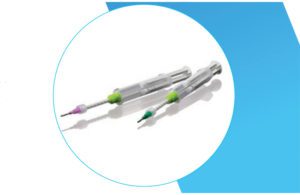
[Image courtesy of Avantor]
A silicone dispensing system takes a new approach to sterilization in order to achieve in-situ curable silicone. This dispensing system allows silicone to be sterilized in the uncured form, opening new possibilities for silicone-based medical devices.
“Silicones are widely used in the medical device field in a variety of applications, and they do various jobs,” noted Julie Cameron, VP of business development and marketing at NuSil, an Avantor brand.
Cameron explained the materials are often used for therapies in the fields of neurology, cardiology, orthopedics and gynecology. “The innovative silicone dispensing system makes it possible for medical device manufacturers to create devices that will form in the body to the patient’s anatomy,” she said.
There are various processes available to sterilize silicones. However, many of these processes have posed challenges in the past when it comes to sterilization of silicones in their uncured state.
Gamma and electron beam sterilization can increase cross-linking, causing premature curing, Cameron explained. Dry heat and autoclave sterilization may be detrimental for heat- or moisture-sensitive formulation ingredients and packaging components.
Nusil’s development harnesses ethylene oxide (EtO) and gas-permeable packaging. “EtO can permeate both the package and the silicone for proper sterilization, without significant effects to the raw material,” Cameron said.
The ethylene oxide does not significantly change key silicone physical properties such as rheology, durometer, modulus, work time and cure rate. Once the sterilant gas is removed, the silicone is sterilized and ready for inclusion in the surgical kit.
Permeable packaging is used in conjunction with addition cure, platinum catalyzed chemistry. Cameron noted that this cure system is desirable and accepted in the medtech industry because it has single-digit parts-per-million catalysts and no byproducts.
Silicone-based implanted devices have multiple therapeutic applications. Depending on how it is used, each device has unique physical property requirements, such as firmness, cushioning ability or flexibility.
“The silicone can be highly customized so that device makers are able to select the exact properties they need,” Cameron said. She noted that device makers often ask for properties such as elasticity, fatigue resistance and durometer to increase the functionality of a device. The material can also be tailored for radiopacity, and either insulative or conductive properties.
Cameron said the new dispensing system could enable new therapies to be developed – ones that could not be done before because of the surrounding morphology. It serves as a means to provide an alternate method of surgical implantation, where uncured, pre-sterilized silicone can be provided as a part of the surgical kit and formed within the body during the surgical procedure, resulting in a custom-fit device.


